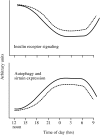Oxidative stress and aberrant signaling in aging and cognitive decline
- PMID: 17517043
- PMCID: PMC1974775
- DOI: 10.1111/j.1474-9726.2007.00294.x
Oxidative stress and aberrant signaling in aging and cognitive decline
Abstract
Brain aging is associated with a progressive imbalance between antioxidant defenses and intracellular concentrations of reactive oxygen species (ROS) as exemplified by increases in products of lipid peroxidation, protein oxidation, and DNA oxidation. Oxidative conditions cause not only structural damage but also changes in the set points of redox-sensitive signaling processes including the insulin receptor signaling pathway. In the absence of insulin, the otherwise low insulin receptor signaling is strongly enhanced by oxidative conditions. Autophagic proteolysis and sirtuin activity, in turn, are downregulated by the insulin signaling pathway, and impaired autophagic activity has been associated with neurodegeneration. In genetic studies, impairment of insulin receptor signaling causes spectacular lifespan extension in nematodes, fruit flies, and mice. The predicted effects of age-related oxidative stress on sirtuins and autophagic activity and the corresponding effects of antioxidants remain to be tested experimentally. However, several correlates of aging have been shown to be ameliorated by antioxidants. Oxidative damage to mitochondrial DNA and the electron transport chain, perturbations in brain iron and calcium homeostasis, and changes in plasma cysteine homeostasis may altogether represent causes and consequences of increased oxidative stress. Aging and cognitive decline thus appear to involve changes at multiple nodes within a complex regulatory network.
Figures




References
-
- Adair JC, Knoefel JE, Morgan N. Controlled trial of N-acetylcysteine for patients with probable Alzheimer's disease. Neurology. 2001;57:1515–1517. - PubMed
-
- Akaishi T, Nakazawa K, Sato K, Saito H, Ohno Y, Ito Y. Hydrogen peroxide modulates whole cell Ca2+ currents through L-type channels in cultured rat dentate granule cells. Neurosci. Lett. 2004;356:25–28. - PubMed
-
- Aoyama K, Suh SW, Hamby AM, Liu J, Chan WY, Chem W, Swanson RA. Neuronal glutathione deficiency and age-dependent neurodegeneration in the EAAC1 deficient mouse. Nat. Neurosci. 2006;9:119–126. - PubMed
-
- Balaban RS, Nemoto S, Finkel T. Mitochondria, oxidants, and aging. Cell. 2005;120:483–495. - PubMed
-
- Balu M, Sangeetha P, Murali G, Panneerselvam C. Age-related oxidative protein damages in central nervous system of rats: modulatory role of grape seed extract. Int. J. Devl. Neuroscience. 2005;23:501–507. - PubMed
Publication types
MeSH terms
Substances
LinkOut - more resources
Full Text Sources
Other Literature Sources
Medical

